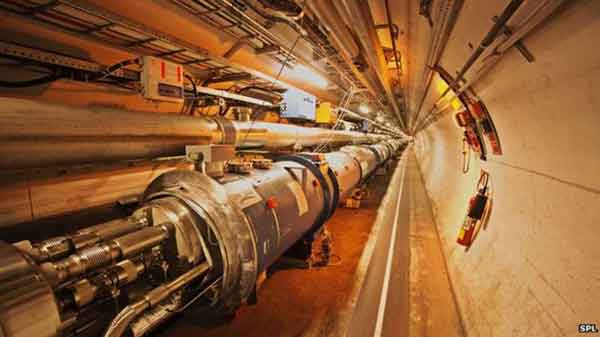
Sheffield, UK (BBN)-The Large Hadron Collider has re-started scientific investigations after a two-year pause.
Scientists are waiting for the first new data to start flowing from the underground particle smasher, paving the way to a new era in physics.
On Wednesday, the vast machine clattered proton beams together at much higher energies than were achieved during its first run from 2010-2013, reports BBC.
This should allow physicists to hunt for signs of new scientific phenomena.
Situated 100m beneath tranquil countryside on the Franco-Swiss border, the particle smasher operated by Cern has already carried out test collisions at the energy of 13 trillion electron volts (TeV), up from a high mark of 8 TeV achieved during the machine's first run.
Now, with the first "physics collisions", scientists can begin their work.
At 0940, operators at the control room in Geneva guided two stable beams of proton particles around the LHC before slamming them into one another at designated points along the 27km-long underground ring.
Huge detectors stationed at these positions began recording the energetic smash-ups, capturing the information necessary to eventually identify exotic new particles in the sub-atomic wreckage.
Cern's outgoing director-general Rolf Heuer congratulated staff, calling it a "fantastic achievement". He cautioned against expecting too much in the way of results, too early, adding: "It's not going to happen tomorrow... be patient."
But he explained: "We are living through a fantastic moment."
Fabiola Gianotti, the director-general elect, added: "A higher energy will allow us to address the great outstanding questions in particle physics."
Sergio Bertolucci, Cern's head of research, commented: "We have the best ship in the world, we have the best crew, now we are ready to go on the next exploration."
He added: "We are going into a vastly uncharted space and there could be big surprises."
The engineers encountered some problems with the machine earlier on Wednesday morning, and at one stage had to "dump", or shut down, the proton beams. But they overcame the technical issues to begin the first collisions.
During its initial run, the LHC bagged the Higgs boson - the last missing piece in the Standard Model, which has been the predominant theory of particle physics since the 1970s.
But the boost in energy is vital for punching through to a new domain where further discoveries about the Universe are possible.
"This period is really when we start to get the first significant data from the 13 TeV collisions. It is a bit like turning on a tap, but this is just the start," Dan Tovey, professor of particle physics at the University of Sheffield, UK, told BBC News.
"Over the next few months, the rate of collisions will increase very significantly, so that by the middle of the summer we'll have sufficient data that we can begin breaking new ground in our searches for new physics beyond the Standard Model, that we couldn't probe with the previous run of the LHC."
Early discoveries could include hitherto unseen "partner" particles to those in the Standard Model that are part of a scheme known as supersymmetry, or SUSY.
Many physicists had hoped to detect hints of SUSY before the LHC's shutdown in early 2013, but with no evidence having been found so far, a major theoretical re-think has been required, with some variants of the scheme being tossed on the bonfire.
Prof Tovey says this had a "big impact" on the field, but adds "there is a huge region of parameter space that is still allowed and so hopes of a discovery are high". Like many particle physicists, he thinks supersymmetry is the best current framework for explaining some of the limitations of the Standard Model.
One of the first supersymmetric particles to be detected might be one called the gluino. Another novel addition to the zoo of cosmic building blocks might be the particle responsible for dark matter, which makes up some 27% of the Universe.
Because dark matter is expected to be "invisible" at sub-atomic as well as astronomical scales, physicists will have to look for indirect evidence of its production. One of the key signs that dark matter may have been generated is an apparent imbalance in momentum before and after a particle collision known as "missing transverse energy".
"If you see such a signature at the LHC which can't be explained by Standard Model physics, what that's perhaps telling you is that you're turning normal matter into dark matter. If that's the case, the LHC would be acting as a dark matter factory, which is quite a neat idea," said Dan Tovey.
Playing the same tune
The boost to collisions at 13 TeV has been made possible after a two-year programme of repairs and upgrades, including the re-soldering of thousands of connections between the LHC's superconducting magnets after flaws were found.
"We did changes, upgrades and modifications to the machine to make it run at higher energies," Paul Collier, the head of Cern's beam department, told BBC News.
"The thing about the LHC is that you are dealing with many different systems, but they all have to work together to ensure they're playing the same tune."
Over the coming months, he said, "we will slowly bring up the collision rate, but it needs to be done in stable conditions".
The proton beams in the LHC contain as much energy as a speeding train, but each beam contains billions of particles - only a fraction of which will collide at the crossing points.
The energy of two protons colliding in the LHC is equivalent to that of a dozen mosquitoes in flight. But the extraordinary thing about this machine is that the energy is packed into a minuscule space, billions of times smaller than the humble mozzie.
In this way, the collider is able to recreate energy densities close to those that existed just after the Big Bang - allowing physicists to probe the very fabric of the cosmos.